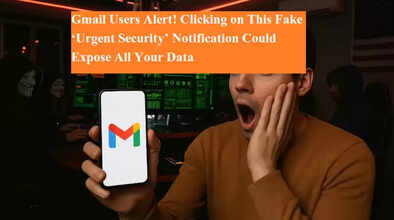Gmail Users Alert! Clicking on This Fake ‘Urgent Security’ Notification Could Expose All Your Data

Gmail Security Scam 2025: If you are among the billions of Gmail users worldwide, it’s time to be extra cautious. Cybercriminals have discovered a new way to trick people into handing over their personal details. Fraudsters are sending fake alerts disguised as official Gmail security notifications under the title “Urgent Security”. The moment a user clicks on these links, hackers gain access to sensitive information such as login credentials, personal data, and even financial details.
A Rising Threat Targeting 2.5 Billion Gmail Users
According to cybersecurity experts, nearly 2.5 billion Gmail accounts are at risk of being targeted by this phishing scam. The fraudulent notification is carefully designed to look like a genuine security alert from Google. Once users open the email and click on the embedded link, they are redirected to a fake login page. By entering their details there, they unknowingly hand over their credentials to hackers.
This deceptive method is part of a growing wave of global phishing attacks, where scammers constantly invent new tricks to bypass user awareness and security measures.
Why Users Fall Into the Trap
The main reason these attacks succeed is due to common user mistakes. Reports suggest that only 36% of Gmail users update their passwords regularly, which makes it easier for hackers to exploit weak or outdated credentials. When users receive alarming notifications claiming “suspicious activity” on their account, they often panic and click without verifying the source.
Hackers take advantage of this fear factor by warning users that immediate action is required. This psychological manipulation is one of the strongest tools in a cybercriminal’s arsenal.
How the Scam Works
Here’s the typical flow of this phishing attack:
-
Fake Email Alert – Users receive an email titled “Urgent Security” that appears to be from Google.
-
Warning Message – The email claims there has been unusual activity on the account and urges immediate verification.
-
Malicious Link – A link is provided asking the user to “secure” their account.
-
Phishing Website – Clicking the link redirects to a fake Gmail login page designed to look identical to the real one.
-
Data Theft – Once users enter their login credentials, the information is instantly stolen by hackers.
Some phishing pages also contain hidden malware designed to infect devices, further compromising security.
How to Stay Safe from Gmail Phishing Scams
To avoid falling victim to these scams, cybersecurity experts and Google recommend the following safety practices:
-
Never click on unknown links in emails or pop-up notifications. Genuine security alerts will not force you into panic-driven actions.
-
Verify the sender’s email address. Even if the display name says “Google Security,” the actual email address might be suspicious or fake.
-
Manually check your account activity. Instead of clicking on links, open a new browser tab, go directly to myaccount.google.com, and review your security settings and recent activity.
-
Enable Two-Factor Authentication (2FA). This adds an extra layer of protection even if your password is compromised.
-
Regularly update your password. Use strong and unique combinations that are difficult for hackers to guess.
-
Report suspicious emails. If you come across such phishing attempts, use Google’s phishing reporting tool to alert the company.
Final Takeaway
Cybercriminals are becoming smarter every day, but users can protect themselves by staying vigilant. Always remember: Google never asks you to share passwords through an email link. If an alert feels suspicious, treat it with caution. By following security best practices, Gmail users can safeguard their accounts and avoid falling prey to phishing attacks.

